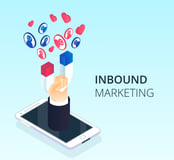Index Content
how can we define an inbound marketing strategy for the IT sector without taking into account our Buyer Persona? What is the Buyer Persona? Does it matter what content we generate as long as we talk about how good our product is?
Inbound strategy for IT
Any marketing strategy pursues the same main objective: to make my product or service known, to stand out from the competition and to finally convert it into a sales opportunity for the user. Can I achieve this regardless of my market?
Yes, but it is essential to define your Buyer Persona.
Buyer Personas are generalised fictitious representations of your ideal customers.
what is the value of knowing my Buyer Persona?
Let's say your product is a mobile application to keep track of your pets' veterinary appointments as well as their vaccination schedule.
what would we write about?
We can talk about how an application helps us to keep track of our pet's health in a generic way, make an ad campaign either in Google AdWords or Facebook Ads talking about the virtues of our mobile application and how useful it is.
However, let's consider that we have the following information about our Buyer Persona:
- Female 25-40 years old
- Lives in the suburbs
- Average income 24000€
- Mother of one child
- Has at least 2 pets at home
- Works as an administrative or receptionist
- Use Facebook on a daily basis
- Before making a purchase, research online for reviews of the item
- Takes her pets with her when the family travels
- Follows pet care blogs
- Belongs to a canine and/or feline association
Let's repeat the question with all this information in mind, what would we write about?
- 7 tips for looking after your pet on holiday
- 5 products your pet will appreciate having
- The 10 most interesting blogs to keep your pet happy
do we see how useful and at the same time necessary it is to invest time in defining our Buyer Persona?
And now, will it be easier for us to target our product advertising in Google AdWords and Facebook Ads?
There is no doubt that better understanding your customers (and potential customers) allows us to generate content that attracts their attention, and it makes it easier for us to personalise the content we create according to their specific needs, behaviours and concerns. This is not an easy task, as it requires research, gathering real data from existing customers as well as potential customers.
We already understand the importance of defining our Buyer Persona, now what?
Let's define the Buyer's Journey
(Buyer's Journey)
Our potential customer, when consuming any content we have created, may be in one of the three stages of the buyer's journey.

- Discovery: the buyer visits our blog and interacts with our social content, looking for answers, resources, education, data and opinions.
- Consideration: Buyer visits pages, benefits or features, and who we are or specialised content area.
- Decision: the buyer visits pricing pages, success stories and contact pages. They are not looking for generic information, they are positioning you on whether to become a customer or not.
We do not want to give content that they do not want to consume before time. Content has a very marked importance in the marketing world. Following the case we gave as an example, if our visitor does not know that she can keep track of veterinary appointments in a mobile application, let's not talk about how good our mobile application is at managing appointments. Does the visitor have that need? Is she looking for solutions to a problem she has? On the contrary, does she want to know how our mobile application adds value to the care of her pet?
Let's think about our Buyer Persona and with that in mind, create quality content that focuses on each stage of the Buyer's Journey. This way we can drive our visitor in such a way that they will want to consume the content created at the right time.
how about an eBook about the legal obligations to comply with when travelling with a pet, or an eBook specifically for travelling with our dog on camping holidays?
We have been talking so far about a very specific case: a mobile application for pet care, but let's extrapolate the model to a company in the IT sector.
how to implement an inbound marketing strategy for the IT sector?
The 6 steps for an inbound marketing strategy:
- Define your Buyer Personas
- Establish your Inbound Marketing objectives
- Define your content strategy
- Create a content calendar
- Define your lead nurturing plan
- Analysis and reporting
what content can you offer?
- Webinar about your product
- eBook showing the solution to an industry problem
- Success stories
- Demo about your product showing how easy it is to implement it
what results will I get?
- Attract users
- Convert them into leads (sales opportunities)
- Close leads into sales
Don't forget to build customer loyalty.




